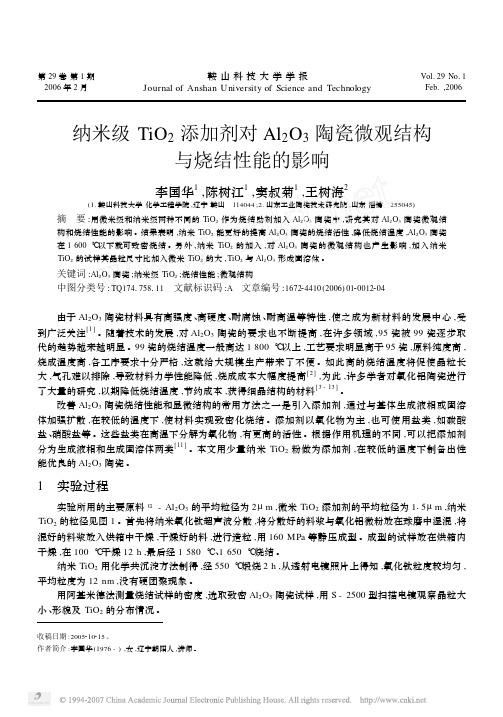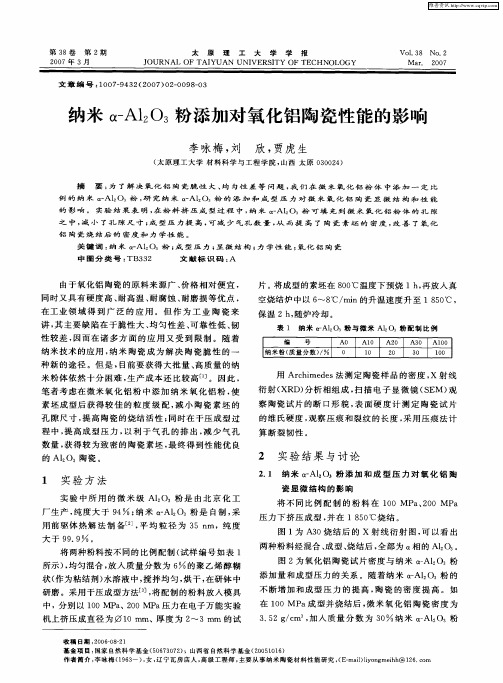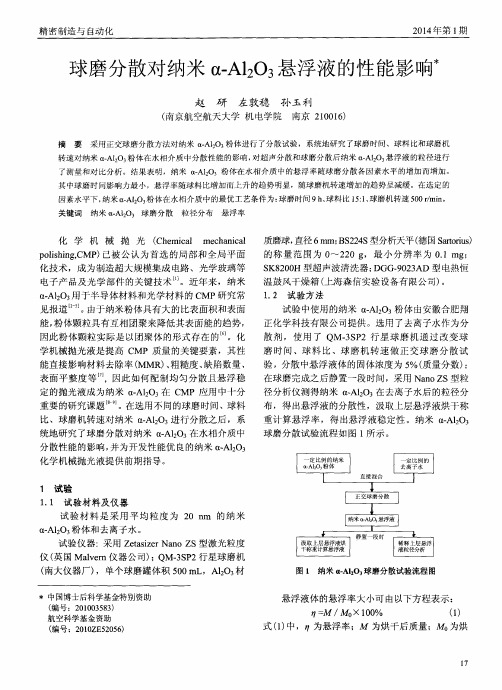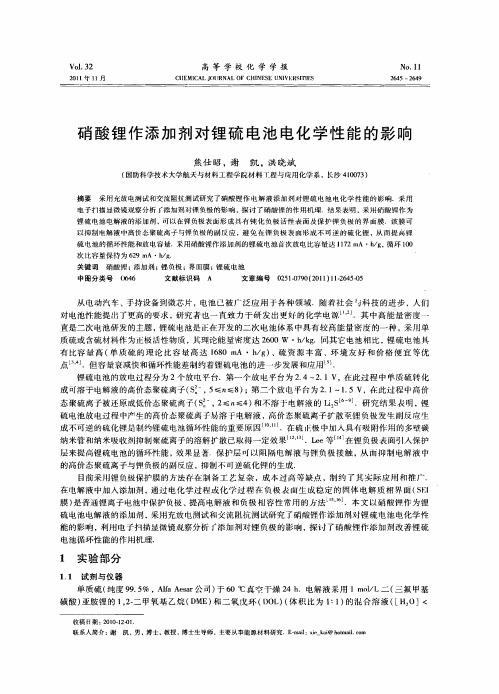Effect of nano-sized Al2O3-particle addition on PVDF ultrafiltration
- 格式:pdf
- 大小:481.08 KB
- 文档页数:6

第29卷第1期2006年2月鞍山科技大学学报Journal of Anshan University of Science and TechnologyVol.29No.1Feb.,2006纳米级TiO2添加剂对Al2O3陶瓷微观结构与烧结性能的影响李国华1,陈树江1,窦叔菊1,王树海2(1.鞍山科技大学化学工程学院,辽宁鞍山 114044;2.山东工业陶瓷技术研究院,山东淄博 255045)摘 要:用微米级和纳米级两种不同的TiO2作为烧结助剂加入Al2O3陶瓷中,研究其对Al2O3陶瓷微观结构和烧结性能的影响。
结果表明,纳米TiO2能更好的提高Al2O3陶瓷的烧结活性,降低烧结温度,Al2O3陶瓷在1600℃以下就可致密烧结。
另外,纳米TiO2的加入,对Al2O3陶瓷的微观结构也产生影响,加入纳米TiO2的试样其晶粒尺寸比加入微米TiO2的大,TiO2与Al2O3形成固溶体。
关键词:Al2O3陶瓷;纳米级TiO2;烧结性能;微观结构中图分类号:TQ1741758111 文献标识码:A 文章编号:167224410(2006)0120012204 由于Al2O3陶瓷材料具有高强度、高硬度、耐腐蚀、耐高温等特性,使之成为新材料的发展中心,受到广泛关注[1]。
随着技术的发展,对Al2O3陶瓷的要求也不断提高,在许多领域,95瓷被99瓷逐步取代的趋势越来越明显。
99瓷的烧结温度一般高达1800℃以上,工艺要求明显高于95瓷,原料纯度高,烧成温度高,各工序要求十分严格,这就给大规模生产带来了不便。
如此高的烧结温度将促使晶粒长大,气孔难以排除,导致材料力学性能降低,烧成成本大幅度提高[2],为此,许多学者对氧化铝陶瓷进行了大量的研究,以期降低烧结温度,节约成本,获得细晶结构的材料[3-13]。
改善Al2O3陶瓷烧结性能和显微结构的常用方法之一是引入添加剂,通过与基体生成液相或固溶体加强扩散,在较低的温度下,使材料实现致密化烧结。



硝酸锂作添加剂对锂硫电池电化学性能的影响熊仕昭谢凯洪晓斌国防科学技术大学航天与材料工程学院材料工程与应用化学系,长沙410073采用充放电测试和交流阻抗测试研究了硝酸锂作电解液添加剂对锂硫电池电化学性能的影响.采用电子扫描显微镜观察分析了添加剂对锂负极的影响,探讨了硝酸锂的作用机理.结果表明,采用硝酸锂作为锂硫电池电解液的添加剂,可以在锂负极表面形成具有钝化负极活性表面及保护锂负极的界面膜.该膜可以抑制电解液中高价态聚硫离子与锂负极的副反应,避免在锂负极表面形成不可逆的硫化锂,从而提高锂硫电池的循环性能和放电容量.采用硝酸锂作添加剂的锂硫电池首次放电比容量达1172 mA·h/g,循环100次比容量保持为629 mA·h/g.硝酸锂;添加剂;锂负极;界面膜;锂硫电池O646A0251-0790 ( 2011 ) 11-2645-052010-12-01谢凯,男,博士,教授,博士生导师,主要从事能源材料研究.E-mail: xie_kai@ hotmail.com比可见,采 , (F) itt LiNO .@@[1 ] Armand M,Tarascon J M.. Nature[ J],2008, 451(7): 652-658@@[ 2] HE Xing-Guang(和兴广),YANG Gui-Ling(杨桂玲),SUN Li-Qun(孙立群),XIE Hai-Ming(谢海明),WANG Rong- Shun(王荣顺).Chem.J.Chinese Universities(高等学校化学学报)[J],2010,31(11): 2148-2152@@[ 3 ] Liang C., Dudney N. J., Howe J. Y.. Chem. Mater.[J],2009, 21(19):4724-4730@@[4] Ji X., Lee K. T., Nazar L. F.. Nature Materials[J],2009,2460(17): 500-506@@[ 5 ] Elazari R., Salitra G. , Talyosef Y., Grinblat J., Kelley C. S., Xiao A. , Affinito J., Aurbacha D.. J. Electrochem. Soc.[ J], 2010, 157(10) : A1131-A1138@@[ 6 ] Yamin H. , Gorenshtein A. , Penciner J. , Sternberg Y. , Peled E.. J. Electrochem. Soc. [ J ], 1988, 135 (5) : 1045-1048@@[ 7 ] Mikhaylik Y. V., Akridge J. R.. J. Electrochem. Soc. [J], 2003, 150(3) : A306-A311@@[ 8 ] Kumaresan K., Mikhaylik Y., White R. E.. J. Electrochem. Soc. [J], 2008, 155(8) : A576-A582@@[ 9 ] Ryua H. S., GuoaZ., Ahn H. J., ChoG. B., Liu H.. J. PowerSources[J],2009, 189(2): 1179-1183@@[ 10] YUAN Ke-Guo(苑克国),WANG An-Bang(王安邦),YU Zhong-Bao(余仲宝),WANG Wei-Kun(王维坤),YANG Yu-Sheng(杨裕 生).Chem.J.Chinese Universities(高等学校化学学报)[J], 2006, 27(9): 1738-1741@@[11] Mikhaylik Y. V., Akridge J. R.. J. Electrochem. Soc.[J], 2004, 151(11): A1969-A1976@@[12] Han S. C., Song M. S., Lee H., Kim H. S., Ahn H. J., Lee J. Y.. J. Electrochem. Soc.[J],2003, 150(7): A889-A893@@[13] Song M. S., Han S. C., Kim H. S., Kim J. H., Kim K. T., KangY. M., Ahn H. J., Dou S. X., Lee J. Y.. J. Electrochem. Soc. [ J ], 2004, 151 (6) : A791 -A795@@[ 14] Lee Y. M., Choi N. S., Park J. H., Park J. K.. J. Power Sources[J], 2003, 119-121:964-972@@[ 15] Ota H. , Akai T. , Namita H. , Yamaguchi S. , Nomura M.. J. Power Sources[J], 2003, 119-121:567-571@@[ 16] TIAN Lei-Lei(田雷雷),ZHUANG Quan-Chao(庄全超),WANG Rong(王蓉),CUI Yong-Li(崔永莉),FANG Liang(方亮),QIANG Ying-Huai(强颖怀).Chem.J.Chinese Universities(高等学校化学学报)[J], 2010, 31(12): 2468-2473@@[ 17] Aurbach D. , Gamolsky K. , Markovsky B. , Gofer Y. , Schmidt M. , Heider U.. Electrochim. Acta[J] , 2002, 47(9) : 1423-1439@@[ 18] Cheon S. E., Ko K. S., Cho J. H., Kim S. W., Chin E. Y.. J. Electrochem. Soc. [J], 2003, 150(6) : A800-A805@@[19] Lópcz C. M., Vaughey J. T., Dees D. W.. J. Electrochem. Soc. [J], 2009, 156(9): A726-A729@@[20] Aurbach D., Pollak E., Elazari R., Salitra G., Kelley C. S., Affinitob J.. J. Electrochem. Soc. [J], 2009, 156(8) : A694-A702Effect of LiNO3 as Additive on Electrochemical Properties of Lithium-sulfur BatteriesXIONG Shi-Zhao XIE KaiHONG Xiao-Bin硝酸锂作添加剂对锂硫电池电化学性能的影响作者:熊仕昭, 谢凯, 洪晓斌, XIONG Shi-Zhao, XIE Kai, HONG Xiao-Bin作者单位:国防科学技术大学航天与材料工程学院材料工程与应用化学系,长沙,410073刊名:高等学校化学学报英文刊名:Chemical Journal of Chinese Universities年,卷(期):2011,32(11)被引用次数:1次1.Armand M;Tarascon J M查看详情[外文期刊] 2008(07)2.和兴广;杨桂玲;孙立群;谢海明 王荣顺查看详情 2010(11)3.Liang C;Dudney N J;Howe J Y Hierarchically Structured Sulfur/Carbon Nanocomposite Material for High-Energy Lithium Battery [外文期刊] 2009(19)4.Ji X;Lee K T;Nazar L F查看详情[外文期刊] 2009(17)5.Elazari R;Salitra G;Talyosef Y;Grinblat J Kelley C S Xiao A Affinito J Aurbacha D查看详情 2010(10)6.Yamin H;Gorenshtein A;Penciner J;Sternberg Y Peled E查看详情[外文期刊] 1988(05)7.Mikhaylik Y V;Akridge J R Low Temperature Performance of Li/S Batteries[外文期刊] 2003(03)8.Kumaresan K;Mikhaylik Y;White R E查看详情[外文期刊] 2008(08)9.Ryua H S;GuoaZ;Ahn H J;ChoG B Liu H Investigation Of Discharge Reaction Mechanism Of Lithium|liquid Electrolyte|sulfur Battery[外文期刊] 2009(02)10.苑克国;王安邦;余仲宝;王维坤 杨裕生1,3-二氧戊环基LiCF3SO3电解液对锂硫电池正极材料单质硫的电化学性能影响[期刊论文]-高等学校化学学报 2006(09)11.Mikhaylik Y V;Akridge J R Polysulfide Shuttle Study in the li/S Battery System[外文期刊] 2004(11)12.Han S C;Song M S;Lee H;Kim H S Ahn H J Lee J Y Effect of Multiwalled Carbon Nanotubes on Electrochemical Properties of Lithium/Sulfur Rechargeable Batteries[外文期刊] 2003(07)13.Song M S;Han S C;Kim H S;Kim J H Kim K T KangY M Ahn H J Dou S X Lee J Y Effects of Nanosized Adsorbing Material on Electrochemical Properties of Sulfur Cathodes for Li/S Secondary Batteries[外文期刊] 2004(06)14.Lee Y M;Choi N S;Park J H;Park J K查看详情 200315.Ota H;Akai T;Namita H;Yamaguchi S Nomura M查看详情 200316.田雷雷;庄全超;王蓉;崔永莉 方亮 强颖怀Li2CO3添加剂对石墨电极性能的影响[期刊论文]-高等学校化学学报 2010(12)17.Aurbach D;Gamolsky K;Markovsky B;Gofer Y Schmidt M Heider U A short review of failure mechanisms of lithium metal and lithiated graphite anodes in liquid electrolyte solutions[外文期刊] 2002(09)18.Cheon S E;Ko K S;Cho J H;Kim S W Chin E Y Rechargeable Lithium Sulfur Battery[外文期刊] 2003(06)19.Lópcz C M;Vaughey J T;Dees D W Morphological Transitions on Lithium Metal Anodes[外文期刊] 2009(09)20.Aurbach D;Pollak E;Elazari R;Salitra G Kelley C S Affinitob J On the Surface Chemical Aspects of Very High Energy Density, Rechargeable Li-Sulfur Batteries[外文期刊] 2009(08)引用本文格式:熊仕昭.谢凯.洪晓斌.XIONG Shi-Zhao.XIE Kai.HONG Xiao-Bin硝酸锂作添加剂对锂硫电池电化学性能的影响[期刊论文]-高等学校化学学报 2011(11)。

纳米Al2O3掺杂对厚膜应变电阻性能的影响
马以武
【期刊名称】《功能材料》
【年(卷),期】1998(029)004
【摘要】采用粒子尺寸为8nm的纳米Al2O3作掺杂改性剂,通过选择合适粒径和配比的导电相、玻璃及烧结工艺,得到一种GF为13、电阻温度系数小、稳定性良好的在厚膜应变电阻,并从厚膜电阻导电机理和纳米材料特性出发。
【总页数】4页(P386-389)
【作者】马以武
【作者单位】中国科学院合肥智能机械研究所
【正文语种】中文
【中图分类】TP212.04
【相关文献】
1.厚膜电阻材料的物化特性对钌系厚膜电阻应变系数的影响 [J], 陈建群;马以武
2.烧结过程中毛细作用对钌基厚膜应变电阻的影响 [J], 丁鹏;马以武
3.毛细作用在钌基厚膜应变电阻烧结过程中的作用和影响 [J], 丁鹏;马以武
4.CuO掺杂SrFe0.9Sno.1O3-δ负温度系数厚膜热敏电阻的电学性能 [J], 袁昌来;巫秀芳;刘心宇;黄静月;李擘;梁梅芳;莫崇贵
5.TiB_2掺杂对316L不锈钢厚膜电阻抗氧化性能的影响 [J], 周宏明;简帅;李荐因版权原因,仅展示原文概要,查看原文内容请购买。

全氟磺酸-聚偏氟乙烯复合纳米纤维的制备与表征李芳冰;董哲勤;魏永明;许振良;杨虎【摘要】以全氟磺酸(PFSA)为聚合物主体,加入疏水聚合物聚偏氟乙烯(PVDF)共混,通过静电纺丝制备了PFSA-PVDF复合纳米纤维.通过电导率、黏度、表面张力、动态光散射、扫描电镜以及差示扫描量热(DSC)等表征手段系统考察了共混体系中聚合物的配比对溶液性质及纤维膜的形态结构和性能的影响.结果表明:PVDF与PFSA之间具有较强烈的相互作用,导致纺丝溶液的黏度增加,从而有效提高溶液的可纺性.随着纺丝液中PVDF的含量提高,复合纤维的直径分布变得均匀.【期刊名称】《功能高分子学报》【年(卷),期】2015(028)003【总页数】6页(P331-336)【关键词】静电纺丝;全氟磺酸;纳米纤维;膜材料【作者】李芳冰;董哲勤;魏永明;许振良;杨虎【作者单位】华东理工大学化工学院,化学工程联合国家重点实验室,上海200237;华东理工大学化工学院,化学工程联合国家重点实验室,上海200237;华东理工大学化工学院,化学工程联合国家重点实验室,上海200237;华东理工大学化工学院,化学工程联合国家重点实验室,上海200237;华东理工大学化工学院,化学工程联合国家重点实验室,上海200237【正文语种】中文【中图分类】TQ028.8全氟磺酸(PFSA)离子交换树脂具有良好的化学稳定性和热稳定性,可作为异构化、酰化、醚化、酯化、烷基化等反应的催化剂,或者作为质子交换膜燃料电池应用于电动汽车等领域[1]。
然而PFSA价格昂贵,限制了其大规模的广泛应用。
常规使用的PFSA为致密膜结构,因此改变PFSA的形态结构可以提高PFSA的应用效率,拓展其应用领域方向。
静电纺丝法是目前制备纳米纤维的重要方法[2]。
但是由于PFSA特殊的两亲性分子结构,其分子间缺乏强烈的相互作用,导致电纺中很难形成稳定的纤维。
要克服这一问题,通常需要加入其他聚合物共混静电纺丝[3-4]。
专业外语总结(字母顺序版)1、热处理和材料科学与工程四要素关系:材料科学与工程四要素关系:Performance 使用性能组成与结构合成与制备过程Synthesis and processingComposition and structure性质Properties2、材料科学与工程的范围(虚线)及其与基础科学及使用间的关系单词&短语表Aa significant breakthrough Important progress 重要进展。
actuators 制(致)动器、Advanced ceramics 高级陶瓷;先进陶瓷 AFM =原子力显微镜=Atomic Force MicroscopeAgglomerates (or aggregates) and aerogels 凝聚物和气凝胶 Alumina 氧化铝Amorphous 非晶的 Anion 阴离子anisotropic 各向异性的anode阳极axial projection轴投影BBCC=body-centered cubic体心立方Bioceramics生物陶瓷biodegradable adj. 生物所能分解的Biodegradable systems生物可降解系统biodegradable可生物降解的bio-inspired medical prostheses仿生医学人工器官。
biological tagging生物标记biomedical applications生物医学应用。
biomimetic adj. 仿生的biomolecular single-electron devices生物分子的单电子器件Biotechnology生物技术bivalent/divalent二价的。
bulk acoustic waves BAWs体声波Bulk material 体材料CCapacitor电容器carbon Nanotube碳纳米管Catalyst催化剂Cathode 阴极Cation 阳离子Cement水泥; 接合剂ceramic based composites陶瓷基复合材料Ceramic coating 陶瓷涂层Chemical Composition化学成分Chemical reagent化学试剂civil engineering土木工程Cold isostatic pressing(CIPing) 冷等静压compacting equipment压实设备。
纳米al2o3粒子的制备纳米AL2O3粒子是一种特殊的纳米材料,具有独特的结构、物质性质和力学弹性性质,它的使用范围越来越广泛。
本文将介绍纳米AL2O3粒子的制备过程和其特性及其在工业上的应用。
一、纳米AL2O3粒子特性1、结构特性:纳米AL2O3粒子是一种特殊的纳米材料,具有均匀、细小和具有可控制性的结构特性。
纳米AL2O3粒子结构由六边形和八边形晶格结构构成,晶粒尺寸约为10-200nm。
2、物质性质:纳米AL2O3粒子具有独特的物质性质,大量的纳米AL2O3粒子可以形成类似纤维的结构,同时具有较高的导电性、耐热、耐腐蚀及较高的磁性等特性。
3、力学弹性:纳米AL2O3粒子具有独特的力学弹性性质,表现为具有较高的弹性模量、低等级抗弯曲性能,以及较高的抗压性能,能够抵抗外界的拉力和磨损。
二、纳米AL2O3粒子的制备纳米AL2O3粒子的制备是研究纳米AL2O3的关键,一般有以下方法进行制备:1、气相沉积法:用液相原料沉积在特定的衬底上,通过激光照射或者溅射的方式,最终形成纳米AL2O3粒子。
2、液相沉积法:用锆酸锌、氢氧化铝和硅胶等液相原料,搅拌混合后,在恒温恒湿环境下进行沉积,经过凝固、烧结和热处理,最后形成纳米AL2O3粒子。
3、溅射和烧结法:将原料放置在反应管内,经过适当的加热和冷却,最终形成纳米AL2O3粒子。
三、纳米AL2O3粒子的应用纳米AL2O3粒子的应用非常广泛,如催化剂、防腐剂、材料加工助剂、电子绝缘材料、磁性材料等。
1、催化剂:纳米AL2O3粒子具有良好的高活性、高热稳定性和良好的结构稳定性等特性,因此它可以作为有效的催化剂在有机合成反应中发挥作用。
2、防腐剂:纳米AL2O3粒子作为一种新型的氧化防腐剂,具有良好的抗腐蚀性能,可以有效抑制金属表面的腐蚀。
3、材料加工助剂:纳米AL2O3粒子的结构性质使其具有独特的力学弹性性质,可以作为加工助剂抗磨损和抗冲击、延长工件的使用寿命。
纳米氧化铝颗粒对高性能环氧树脂玻璃化转变温度的影响张宗华;刘刚;张晖;张忠;王小群【摘要】采用机械分散工艺制备了Al2 O3/环氧复合材料,研究了颗粒含量和颗粒表面改性对复合材料玻璃化转变温度(Tg)的影响规律.结果表明:微米颗粒的加入并未改变环氧树脂的Tg,而纳米颗粒的加入则产生了较大影响.当未表面改性的Al2O3纳米颗粒含量超过10%(质量分数,下同)时,复合材料的Tg开始下降;纳米颗粒含量为18%时,相比纯树脂体系,复合材料的Tg下降了约25℃.经过辛基硅烷表面改性的纳米Al2 O3颗粒与树脂的相容性得到改善,对体系的增黏效果减小,复合材料的Tg降低幅度较小.【期刊名称】《材料工程》【年(卷),期】2014(000)009【总页数】6页(P39-44)【关键词】玻璃化转变温度;纳米复合材料;氧化铝;环氧树脂【作者】张宗华;刘刚;张晖;张忠;王小群【作者单位】北京航空航天大学材料科学与工程学院,北京100191;北京航空材料研究院先进复合材料重点实验室,北京100095;国家纳米科学中心,北京100190;国家纳米科学中心,北京100190;北京航空航天大学材料科学与工程学院,北京100191【正文语种】中文【中图分类】TB332环氧树脂具有优异的物理力学性能、黏合力强、化学稳定性好,作为涂料、胶黏剂、电绝缘体等在航空航天领域得到广泛应用。
由于无机纳米颗粒具有纳米尺寸效应,高的比表面积和强的界面作用,与环氧树脂复合后可有效提高其力学性能、电性能和热性能[1-6]。
然而,与复合材料力学性能相比,环氧树脂的玻璃化转变温度(Tg)随纳米颗粒含量的变化规律及其原因尚需进一步研究。
已有的研究结果认为纳米颗粒由于具有高比表面积,会限制其周围高分子的链段运动,从而使得环氧树脂的Tg 提高[1,7-9]。
例如,Wetzel等[1]发现随着纳米Al2O3含量的增加,环氧/纳米复合材料的Tg提高,他们将其归因于纳米粒子与树脂基体的相互作用,导致树脂基体链段的移动性变差。
Journal of Membrane Science276(2006)162–167Effect of nano-sized Al2O3-particle addition on PVDF ultrafiltrationmembrane performanceLu Yan a,b,Yu Shui Li a,∗,Chai Bao Xiang a,Shun Xianda ca Department of Municipal and Environmental Engineering,Harbin Institute of Technology,Harbin150090,Chinab Department of Chemistry,Daqing Petroleum Institute,Daqing163318,Chinac Daqing OilField E&P Research Institute,Daqing631712,ChinaReceived2April2005;received in revised form19September2005;accepted20September2005Available online19October2005AbstractA polyvinylidenefluoride(PVDF)ultrafiltration(UF)membrane was modified by dispersing nano-sized alumina(Al2O3)particles uniformly in a PVDF solution(19%polymer weight).Membranes were prepared by a phase-inversion process and using UF experiments comparing waterflux and, molecular-weight cut-offs for the wet membranes.The contact angle between water and the membrane surface was measured in order to quantify the hydrophilicity changes of the membrane surface.Membranes surface morphology,surface and cross-sectional structures,and nanometer-particle distribution on the membrane surface were examined by atomic-force microscopy(AFM),scanning electron microscopy(SEM),and confocal laser-scanning microscopy(CLSM),respectively.Thermal analysis(DSC)was performed in order to investigate the interactions between membrane components.The effects of the nanometer Al2O3-particles concentration in the polymer dope on the permeation properties,membrane strength, and anti-fouling performance were examined.The experimental results indicated that Al2O3–PVDF composite membranes exhibit significant differences in surface properties and intrinsic properties due to nanometer-particles addition.©2005Elsevier B.V.All rights reserved.Keywords:Membrane fouling;Nano-sized Al2O3particles;Polyvinylidenefluoride;Ultrafiltration membrane1.IntroductionUltrafiltration has been used extensively in many membrane-separation processes,especially in the wastewater treatment field,including oil–water and protein effluent separation[1–7]. The hydrophilicity of the membrane and its porous structure play important roles in membrane-separation processes.A suit-able porous membrane must have high permeability,good hydrophilicity,and excellent chemical resistance to the feed streams.In order to obtain high permeability,membranes should have high surface porosity and good pore structure.An asymmet-ric membrane is ideal for this purpose.Polyvinylidenefluoride (PVDF)is one material that can form,such asymmetric mem-branes.This polymer is thermally stable and resistant to corro-sion by most chemicals and organic compounds.PVDF-based membranes show outstanding anti-oxidation activities,strong ∗Corresponding author.Tel.:+8645186282101.E-mail address:yushuili163@(Y.S.Li).thermal and hydrolytic stabilities,and good mechanical andfilm-forming properties.PVDF membranes can thus be used in many ultrafiltration processes through various modifications.Many studies have attempted to improve the performance of PVDF membranes using various techniques,including physi-cal blending,chemical grafting,and surface modifications.The blending of polymers has the advantage of easy preparation using phase inversion.The addition of hydrophilic materials to the dope solution increases the water permeability of a mem-brane with similar pore size and pore distribution,due to an increase in pore density as well as in the hydrophilicity of the membrane surface and inside the pores[8,9].Polymethyl methacrylate(PMMA)is an organic material that is commonly blended with PVDF.The addition of hydrophilic PMMA not only improves the membrane pore size distribution and pore structure,but also enhances its permeation performance without a loss of retention[10,11].Additional organic materials that can improve PVDF membrane properties include polymethy acry-late(PMA)[12,13],polyvinyl acetate(PV AC)[14],and cellu-lose acetate(CA)[15].The addition of organic hydrophilic mate-0376-7388/$–see front matter©2005Elsevier B.V.All rights reserved. doi:10.1016/j.memsci.2005.09.044L.Yan et al./Journal of Membrane Science276(2006)162–167163rials can improve some properties of membranes,but reduces membrane strength.Recent studies of PVDF-blending modifications have focused on blending the polymer with inorganic materials.The addition of inorganicfillers has led to increased membrane per-meability and improved control of membrane-surface properties [16–18].Inorganic materials that can be blended with PVDF include silica[18],zirconium dioxide(ZrO2)[19],and some small molecule inorganic salts,such as lithium salts[20].The common feature of these modifications is the addition of a higher proportion of inorganic materials.SiO2–PVDF,ZrO2–PVDF, and LiClO4–PVDF have ratios of inorganic particles to PVDF of 0.2,1.0,and0.128,respectively[18–20].The PVDF-membrane morphology and elasticity are both significantly affected by the mass of inorganic materials added.In the present study,PVDF UF membranes were modified by inorganic nano-sized Al2O3particles.This research aimed to prepare Al2O3–PVDF composite membranes using the phase-inversion method by including a small proportion of Al2O3 particles but effectively improving the membrane performance. The effects of the Al2O3-particle concentration in the casting solution on the membrane hydrophilicity,permeationflux,mor-phology,mechanical properties,and anti-fouling performance were examined.2.Experimental2.1.MaterialsThe PVDF used was a commercial product(FR904). Dimethylacetamide(DMAC;>99%,reagent)was employed as the solvent.Alumina(Al2O3)particles(10nm in size)were added to PVDF solutions.The other additives were sodium hexad-phosphate and polyvinyl pyrrolidone(PVP).A mixture of distilled water and ethanol was used as the nonsolvents for the polymer precipitation.2.2.Membrane preparationAl2O3–PVDF composite membranes were prepared by the phase-inversion method.Casting dopes were prepared by dis-solving the PVDF in the solvent at room temperature and adding nano-sized Al2O3particles and other additives to the casting dopes under stirring.In order to obtain optimal dispersions of the particles in the polymer solutions,agitation was required for at least24h.The casting solutions were then kept in the dark for at least24h to remove air bubbles.An appropriate amount of the dope was dispersed uni-formly on a glass plate.After30s exposure to air,the glass plate was immersed in a bathfilled with distilled water and ethanol.Different Al2O3-particle concentrations(0–4%,by weight of PVDF)of polymer dopes consisting of PVDF(19%,by weight of the solution),DMAC(78%,by weight of the solution),and additives(1%sodium hexad-phosphate,by weight of PVDF; 3%PVP,by weight of the solution)were prepared;these were labeled as PVDF-0,PVDF-1,PVDF-2,PVDF-3,and PVDF-4,respectively.The membranes formed were washed with,and soaked in,distilled water until they were used as samples for characterization.2.3.Characterization of membraneThe membrane-permeation properties were tested in a UF laboratory unit(effective area=32.3cm2)fed with distilled water at different transmembrane pressures(ranging from0.1 to0.4MPa).The same unit was fed with proteins of dif-ferent molecular weights that is,cell pigment C(molecu-lar weight=12,400),pepsin(molecular weight=35,000),and bovine serum albumin(molecular weight=67,000)in order to obtain the molecular-weight cut-off values of membranes. The membrane porosities were measured using dry–wet weight method.The contact angle between water and the membrane surface was measured with a contact-angle measurement appa-ratus(DSA10,American,needlepoint size=1.5mm)accord-ing to the sessile-drop method.Briefly,a water droplet was deposited on aflat homogeneous membrane surface and the contact angle of the droplet with the surface was measured. The value was observed until there was no change in con-tact angle during the short measurement period.Each con-tact angle was measuredfive times atfive different points of each membrane sample and an average value was calcu-lated.The tensile strength and elongation-at-break of the mem-branes were determined using a universal electronic strength measurement instrument(W-56).The measurements were carried out at room temperature and the rate of pull was 2mm/min.The surface and cross-sectional structures of the membranes were examined by scanning electron microscopy(SEM;S-4700,Japan).Cross-sections were prepared by fracturing the membranes at the temperature of liquid nitrogen.All spec-imens were coated with a thin layer of gold before being observed using SEM.The membrane surface morphology,in terms of the mean surface roughness(R a),was studied by atomic-force microscopy(BioScope TM,USA)using the tap-ping mode.The mean roughness was defined as the average value of the surface relative to the center plane for which the volumes enclosed by the images above and below the plane were equal.This parameter was calculated using the following equation[21]:R a=1L x L yLxLy|f(x,y)|d x d yHere,f(x,y)is the surface relative to the central plane,and L x and L y are the dimensions of the surface.The nanometer-particle distribution in the modified mem-brane was analyzed based on the differential coefficient-interference pattern identified using confocal laser-scanning microscopy(TCS SP,Germany).Thermal analysis was car-ried out using a differential scanning calorimeter(Pyris,Amer-ica)in order to observe the effect of inorganic particles on the polymer membrane.Membrane fouling was tested in a dead-end ultrafiltration cell fed with1%(weight)␣-amylase solution.164L.Yan et al./Journal of Membrane Science 276(2006)162–1673.Results and discussion3.1.Effect of the addition of nano-sized Al 2O 3particles on membrane fluxMembrane fluxes were affected by the addition of nano-sized Al 2O 3particles.Fig.1shows that increased Al 2O 3concen-trations led to increased water permeate fluxes,although this trend cease when the quantity of the nano-sized Al 2O 3particles reached a certain level.This finding can be interpreted as fol-lows.PVDF is a hydrophobic polymer.Its hydrophilicity can be improved significantly by the addition of nano-sized Al 2O 3particles,which have some favorable characteristics,such as hydrophilicity and higher ratio surface areas.Thus,the water fluxes are increased.However,with casting drops containing more than a certain concentration of nano-sized Al 2O 3particles,the flux cannot be improved further as the nano-sized Al 2O 3par-ticles coalesce.In terms of both economy and practicality,2%(weight)of nano-sized particles in the casting solution are ideal.It can also be seen from Fig.1that the water fluxes improved when the pressure increased for all membranes;this finding was specific to asymmetric microfiltration and ultrafiltration mem-branes.Water fluxes were improved by increasing the driving force.However,an excessive driving force would increase the operating cost of a facility and affect the life expectancy of membranes.In the current experiment,a transmembrane pres-sure of 0.1MPa was employed.Under this pressure differential,the water flux of the PVDF-2membrane was approximately 100L/(m 2h)higher than that of the PVDF-0membrane.3.2.Contact angle,porosity,rejection,and molecular-weight cut-off values of membranesThe contact angle is an important parameter for measur-ing surface hydrophilicity [22,23].In general,a smaller contact angle corresponds to a more hydrophilic material.As can be seen from Table 1,increasing the Al 2O 3-particle concentration caused a decrease of the contact angle.However,the porosity,rejection,and molecular-weight cut-off values were not affectedFig.1.Distilled water fluxes of membranes prepared using dopes with different nano-sized Al 2O 3particles.Table 1Membrane contact angles,porosities,rejection values,and molecular-weight cut-offs Membrane PVDF-0PVDF-1PVDF-2PVDF-3PVDF-4Contact angle (◦)83.6467.8757.4258.6258.97Porosity (%)54.9954.7255.3153.0955.82Rejection (%)95.5096.3196.597.0596.45Molecular-weight cut-off3500035000350003500035000by the Al 2O 3-particle concentration.These results demonstrated that adding Al 2O 3particles to PVDF polymer could improve its hydrophilicity,but did not affect the pores size or the number of pores.As a result,the flux through the composite membranes increased significantly.3.3.Mechanical propertiesThe tensile strength and elongation-at-break of the mem-branes are shown in Table 2.Both values,especially the former,were improved.The elongation-at-break initially increased with the addition of nano-sized particles,reached a peak when the Al 2O 3-particle concentration was 2%(weight)and then declined as the Al 2O 3-particle concentration was further increased.These behaviors indicate that adding an appropriate amount of nano-sized Al 2O 3particles to a PVDF solution can improve the mem-brane’s mechanical properties.However,an excessive amount of inorganic Al 2O 3particles in the cast solution can cause the membrane elasticity to decline,thereby leading to a decrease in the membrane’s elongation-at-break value.Nonetheless,for a membrane consisting of 2%(weight)Al 2O 3particles,the values of both the tensile strength and the elongation-at-break values were increased by more than 50%.3.4.Microstructures of membranesSEM and atomic-force microscopy (AFM)analyses were per-formed to compare the morphological changes between modi-fied and unmodified membranes.Fig.2shows SEM micrographs of the surface,cross-section,and inner porous-surface structures of the membranes PVDF-0and PVDF-2.Micropores were dis-tributed on both membrane surfaces and there were no apparent differences between the modified and unmodified membranes.Both membranes showed typical asymmetric morphology with finger-like pores linked by sponge walls;the latter contained large numbers of micropores that allowed the finger-like pores to communicate with each other.These findings indicate that theTable 2Mechanical properties of membranesTensile strength (N)Elongation-at-break (%)PVDF-013.2031 4.72PVDF-118.3593 5.89PVDF-219.92187.34PVDF-320.2343 6.67PVDF-420.53125.58L.Yan et al./Journal of Membrane Science 276(2006)162–167165Fig.2.SEM micrographs of the membrane surface,cross-section,and inner porous structures:(a,c,and e)PVDF-0and (b,d,and f)PVDF-2.addition of nano-sized Al 2O 3particles did not affect the struc-tures of the surface,cross-section,and inner pores.Therefore,the mechanism of PVDF membrane-structure formation was not altered by the addition of inorganic nano-sized Al 2O 3.Fig.3displays three-dimensional AFM images of the mem-brane surfaces.The surface roughness of the modified membrane was apparently higher than that of the unmodified membrane.In the range of the scan areas 10m ×10m,the R a of the modified and unmodified membranes were 114.0and 64.4nm,respectively.Higher roughness commonly led to two changes in the modified membrane;an increase of efficient filtration area and a decrease of the anti-fouling performance.Because Al 2O 3particles are porous and ceramic,water molecules can permeate to them.Their accumulation on the membrane surface can increase,but not reduce,the effective filtration area of the membrane.The enlarged efficient filtration area increases the membrane flux directly.The membrane-fouling trend increases with roughness owing to contaminants accumulating in the “val-leys”of the rough membrane surface;however,if the increase in roughness is caused by the accumulation of hydrophilic Al 2O 3particles on the membrane surface,it improves the membrane surface hydrophilicity significantly,and reduces the interaction between the contaminants and the membrane surface.Further-more the increased membrane hydrophilicity can enhance the anti-fouling and performance and the permeate flux.These results show that increased membrane-surface roughness does not have a negative effect on membrane performance;rather,it effectively improves the permeating flux and anti-fouling prop-erties.3.5.Al 2O 3-particle distribution in the membraneThe performance of the modified membrane was influenced by the distribution of nano-sized particles.Sodium hexad-phosphate,an anionic surfactant,is used as a dispersant and a crosslinking reagent in order to make inorganic particles dis-perse uniformly in the cast dopes.Fig.4shows a differential coefficient-interference pattern produced using confocal laser-scanning microscopy (CLSM)for the Al 2O 3-particle distribu-tion in the membrane.Fig.4illustrates that most Al 2O 3particles were dispersed uniformly in the membrane,with the exception of a few large clusters that might have resulted from particlers overlapping or from nano-sized particles coalescing in the mem-brane.Fig.3.AFM three-dimensional surface images of membranes:(a)PVDF-0and (b)PVDF-2.166L.Yan et al./Journal of Membrane Science276(2006)162–167Fig.4.Differential coefficient interference pattern of Al2O3-particle distribution in the modified membrane.3.6.Thermal analysisThermal analysis(DSC)was performed on the PVDF-0 and PVDF-2membranes in order to investigatethe interaction between the polymer and the inorganic particles.Thermograms were recorded during cooling and heating at a controlled rate to evaluate their thermodynamic properties.Each sample was heated from50.00to200.00◦C at10.00◦C/min,held for1min at 200.00◦C and then cooled from200.00to50◦C at10.00◦C/min. Fig.5shows that the addition of nano-sized Al2O3particles has no effect on either the melting point or the enthalpy of the crystal-lizations.However,the enthalpy of fusion and the crystallization point declined slightly in the modified membrane compared with the unmodified membrane.This indicated that the addition of Al2O3particles had no effect on crystal formation,although it had a minor effect on crystal perfection during the formation of PVDF membranes[20].Fig.5.DSC thermograms of membranes PVDF-0and PVDF-2.For PVDF-0,the enthalpy of fusion was59.102and the enthalpy of crystallization was −36.173.For PVDF-2,the enthalpy of fusion was50.768J/g and the enthalpy of crystallization was−36.779J/g.Fig.6.Permeate-flux decline with increasing time for the different membranes measured at0.1MPa transmembrane pressure.3.7.Anti-fouling performanceMembrane fouling caused the permeationflux to decline drastically.The mechanism that produces membrane fouling is complex.However,membrane hydrophilicity is the main factor affecting the surface-adsorption properties of the membranes. Fig.6shows that the permeationfluxes of␣-amylase solution for the membranes declined as thefiltration time increased,followed by a long period with a steady value.The rate offlux decline, which was defined as theflux of the membrane at the time of consistentflux divided by the initialflux of the clear mem-brane,was no more than27.4%for the modified membranes;the lowest value was18.2%compared with38.5%for the unmod-ified membrane.This shows that the composite membranes modified by Al2O3particles had a more favorable anti-fouling performance.4.ConclusionsAl2O3–PVDF composite membranes were synthesized using the phase-inversion process.The addition of nano-sized Al2O3 particles did not affect the pore size,pore numbers,or crystal formation of the PVDF membranes.Although the membrane-surface morphology was altered by increased of surface rough-ness,it had no negative effects on membrane permeability or anti-fouling performance.The permeation-flux increase of the modified membrane was attributed to increases in the surface hydrophilicity and the efficientfiltration area due to the addition of hydrophilic inorganic nano-sized Al2O3particles.The tensile strength and break elongate ratio values of the membrane were improved more than50%for the membrane that consisted of 2%(weight)Al2O3particles.The improved hydrophilicity of the composite membrane also enhanced the anti-fouling perfor-mance.Furthermore,the rate offlux decline was only18.2%for the2%(weight)Al2O3-particle membrane at a transmembrane pressure of0.1MPa.L.Yan et al./Journal of Membrane Science276(2006)162–167167AcknowledgementsThe paper was supported by the973National Basic Research Program,the Teaching and Research Award Program for Out-standing Young Teachers in Higher Education Institutions of the Ministry of Education,and the Daqing Science and Technology Bureau,China.References[1]B.Tansel,J.Regula,R.Shalewitz,Treatment of fuel oil and crude oilcontaminated waters by ultrafiltration membranes,J.Desalination102 (1995)301–311.[2]S.H.Lin,n,Waste oil/water emulsion treatment by membraneprocesses,J.Hazard.Mater.59(1998)189–199.[3]J.Kong,K.Li,Oil removal from oil-in-water emulsions using PVDFmembranes,J.Sep.Purif.Technol.16(1999)83–93.[4]I.S.Chang,C.M.Chung,S.H.Han,Treatment of oily wastewater byultrafiltration and ozone,J.Desalination133(2001)225–232.[5]T.Mohammadi,S.S.Madaeni,M.K.Moghadam,Investigation of mem-brane fouling,J.Desalination153(2002)155–160.[6]Z.Ademovic,D.Klee,P.Kingshott,et al.,Minimization of proteinadsorption on poly(vinylidenefluoride),J.Biomol.Eng.19(2002) 177–182.[7]S.Weigert,M.S´a ra,Surface modification of an ultrafiltration membranewith crystalline structure and studies on interactions with selected protein molecules,J.Membr.Sci.106(1995)147–159.[8]B.Jung,Preparation of hydrophilic polyacrylonitrile blend membranesfor ultrafiltration,J.Membr.Sci.229(2004)129–136.[9]J.Marchese,M.Ponce,N.A.Ochoa,P.Pr´a danos,L.Palacio, A.Hern´a ndez,Fouling behaviour of polyethersulfone UF membranes made with different PVP,J.Membr.Sci.211(2003)1–11.[10]S.P.Nunes,K.V.Peinemann,Ultrafiltration membranes fromPVDF/PMMA blends,J.Membr.Sci.73(1992)25–35.[11]N.A.Ochoa,M.Masuelli,J.Marchese,Effect of hydrophilicity on foul-ing of an emulsified oil wastewater with PVDF/PMMA membranes,J.Membr.Sci.226(2003)203–211.[12]M.Pralay,Influence of chain structure on the crystallization mecha-nism of poly(vinylideneflouride)/poly(methyacrylate)blends:evidence of chain extension due to blending,J.Polym.39(1998)413–421.[13]H.J.Mueller,Flator capillary hydrophsisc membrane manufactured froma mixture of poly(vinyli-deneflurfde)and a derivatized polyacrylate,P.EP407900,1991-01-16.[14]B.S.Kim,Physical properties of ultra drawn poly(vinyli-deneflouride)/poly(vinylacetate)blends,J.Pollimo20(1996)297–304.[15]L.Wang Zhan,W.Yaw en,Shumei,et al.,Study on the preparation andcharacteristics of PVDF/CA blend ultrafiltration membrane,J.Membr.Sci.6(2002)4–8.[16]I.Genne,S.Kuypers,R.Leysen,Effect of the addition of ZrO2,topolysulfone based UF membranes,J.Membr.Sci.113(1996)343–350.[17]P.Aerts,A.R.Greenberg,R.Leysen,W.B.Krantz,V.E.Reinsch,P.A.Jacobs,The influence offiller concentration on the compaction andfil-tration properties of Zirfon-composite ultrafiltration membranes,J.Sep.Purif.Technol.22–23(2001)663–669.[18]A.Bottino,G.Capannelli,V.D’Asti,et al.,Preparation and propertiesof novel organic–inorganic porous membranes,J.Sep.Purif.Technol.22–23(2001)269–275.[19]A.Bottino,G.Capannelli,ite,Preparation and characterizationof novel porous PVDF–ZrO2composite membranes,J.Desalination146 (2002)35–40.[20]D.J.Lin,C.L.Chang,F.M.Huang,L.P.Cheng,Effect of salt additiveon the formation of microporous poly(vinylidenefluoride)membranes by phase inversion from LiClO4/water/DMF/PVDF system,J.Polym.44(2003)413–422.[21]M.Khayet, C.Y.Feng,K.C.Khulbe,T.Matsuura,Preparation andcharacterization of polyvinylidenefluoride hollowfiber membranes for ultrafiltration,J.Polym.43(2002)3879–3890.[22]L.Palacio,J.I.Calvo,P.Pradanos, A.Hernandez,P.V¨a is¨a nen,M.Nystr¨o m,Contact angles and external protein adsorption onto ultrafil-tration membranes,J.Membr.Sci.152(1999)189.[23]J.T.F.Keurentjes,J.G.Harbrecht,D.Brinkman,J.H.Hanemaajer,et al.,Hydrophobicity measurements of MF and UF membranes,J.Membr.Sci.47(1989)333–337.。